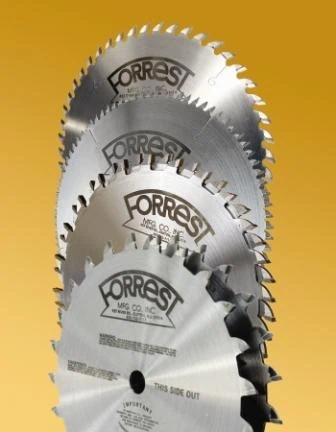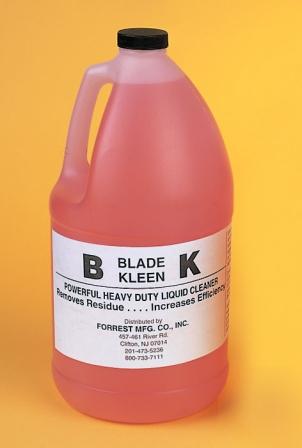Working in the home-improvement industry has its perks. For example, I get a lot of saw blades sent to me as product samples. Sometimes I’m sent more than I can use. Suffice it to say that I’m knee-deep in circular blades and am not the best guy to speak authoritatively on how to properly care for them, since I generally have so many backups at my disposal. Not properly caring for them is a bad habit, I’ll grant you. When the apocalypse dawns, and saw blades are in short supply, I’ll rue the day that I took them for granted. With that grim inevitability in mind, we should all take the time to learn from the following blade-care tips sent to me by Forrest Manufacturing Company (www.ForrestBlades.com). — M. Weber
A Few Basic Precautions Will Help Woodworkers and Hobbyists Protect The Investment They’ve Made in Quality Saw Blades
Proper Handling and Storage: Woodworkers need to be very attentive when storing, cleaning, and using their blades. “Let me say at the outset that it is essential to match the blade to the application,” says Jay Forrest, Vice President of Forrest Manufacturing Company. “For example, you don’t want to cut plastic or acrylic with a blade designed for wood. Some people make the mistake of thinking it won’t matter if they use the wrong blade to make a quick cut. It does matter. The blade can easily be damaged. So always use the correct blade for the type of job you’re doing.”
When it comes to working in the shop, Mr. Forrest warns woodworkers never to rest circular saw blades on steel or cement surfaces. That’s because metal on metal or metal on cement can dull the blade by chipping the top grind (the high point of the tooth). Instead, it’s better to set the blade down on plywood or plastic. He also strongly recommends that individual blades be hung on their own hooks from pegboard or stored individually in a drawer or box in such a way as to prevent them from rubbing together. It is also advisable to avoid excessive moisture or humidity. Otherwise, the blades may rust and/or pit. This can require re-straightening and re-polishing. However, with careful storage and the use of silicon spray, WD40, car wax, or even motor oil, rust and pitting can usually be avoided.
Carrying Case: Vice President Forrest suggests that woodworkers consider purchasing a carrying case for their blades. He says, “The company’s Blade Runner carrying case is great for preventing damage during storage or transit. It is made of high-impact plastic and can accommodate up to ten 10” blades, five on each side.”
Using Saw Blades Safely: Proper operation of the saw itself, as well as the correct installation of the blade, can have an impact on the life and performance of a saw blade. The safety of the operator can also be affected. When installing a blade, operators need to be sure the machine is unplugged, that they wear heavy-duty gloves, and use caution in tightening the arbor. The guard should always be in place. Operators should never jam the blade with a wood block or bear down too much. This can deflect a blade tooth. The objective is simply to be sure the blade is snug. Once the machine is in use, it’s important to avoid overheating the blade by keeping it too low when cutting hardwood. This can create a thermal crack in the carbide, causing tip fragments to fly backward to possibly injure the operator. For this and many other reasons, safety glasses should always be worn.
Never Use a Wire Brush When Cleaning Blades: Keeping circular saw blades clean can play an important role in maintaining good performance. Otherwise accumulated pitch, sap, and other materials may dull the blade, require more push-through force, and generate increased levels of heat through friction. Removing grime can help produce a better cut and make the need for sharpening less frequent. However, great care must be taken to clean blades properly so as not to do potentially serious damage in the process. When cleaning, wear heavy-duty gloves. After that, it is essential to utilize the right cleaning implements. Be sure to use a nylon or brass brush, never wire. Otherwise you are likely to do serious damage. A variety of household cleaners can sometimes do an adequate cleaning job. For example, some woodworkers apply ammonia or Formula 409 Cleaner.
“Our company offers a Blade Kleen kit that features a brush, spray bottle, and an ammonia-based fluid,” says Forrest. “This is the same industrial-strength mixture we use in-house. When diluted with water, our formula does an excellent job of removing pitch, sawdust, and gum. We also offer a concentrated, all-purpose pitch and gum remover called ‘Super Brite.’ It comes with a convenient spray applicator. The container has enough fluid to make over 2-1/2 gallons when diluted per instructions. Be sure to use a clean cloth or soft bristle brush to wipe the blade after soaking it in an appropriate container for about 15 minutes.”
Factory Sharpening is Best
At a time when many other companies no longer offer such services, Forrest Manufacturing continues to provide affordable, in-factory sharpening and repairs of all makes of carbide-tipped circular saw blade.
No matter how carefully a blade is handled, it may eventually become dull through normal wear and tear or by resin build up. Problems may also result when a blade has been damaged by an encounter with some object, such as a nail, or worn down by being used improperly for the wrong application. Forrest’s two-step process utilizes automated, high-speed, diamond-grit machines with flood cooling. First, the front of the tip is sharpened by face grinding. Second, the top cutting edge is fine-finished. Approximately 20 minutes is spent on each blade. And because only a miniscule amount of carbide is removed, a Forrest blade—if operated normally and processed by Forrest’s in-factory experts—can usually be sharpened 8 or 10 times over its life.
In addition to sharpening, Forrest offers a full range of services to restore the operation and effectiveness of damaged carbide-tipped circular saw blades. These repairs and adjustments include straightening bent teeth, replacing tips, re-grinding both sides of all teeth, providing extra top grind for extremely dull blades, opening gullets, tightening or enlarging the bore, welding or replacing steel shoulder, and more. “Many people are surprised by the fact that we sharpen and repair all brands of circular saw blades,” says Forrest. “However, most of the work we do on products produced by other manufacturers involves sharpening or tip replacement. But no matter what make of blade you are sending us or what type of repair you need, please take a little extra time to package the blade properly. That way you can prevent unnecessary damage and avoid additional costs.”
An important safeguard in protecting blades is to always use the proper type of shipping container. Mr. Forrest explains, “If, for example, you are sending two or more blades to us for sharpening or repair, be sure not to pack them in a way that lets the blades rub against one another, or you are likely to get chipping. It’s the same principle as when you are packing dishes. You carefully wrap each dish individually and use bubble pack or other appropriate materials. Otherwise, you will probably have breakage. In the case of saw blades, it’s the tips that tend to break off. Even if you are shipping just one blade, we strongly recommend that you use heavy cardboard. Better yet, consider using two pieces of inexpensive Luan plywood with a bolt through them to create a small container. Of course, if a blade tip breaks off in shipment, we’ll gladly repair it. We certainly have that capability. But replacing tips costs extra. So we encourage our customers to avoid unnecessary expense by carefully packing their blades for mailing or shipping.”
Visit the company’s website at www.ForrestBlades.com.





